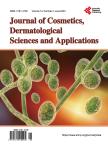Retrospective Study of 23 Cases of Psoriasis Association with HIV Infection Observed in the Department of Dermatology-STD in the University Hospital of Donka Conakry Guinea
Retrospective Study of 23 Cases of Psoriasis Association with HIV Infection Observed in the Department of Dermatology-STD in the University Hospital of Donka Conakry Guinea作者机构:Department of Dermatology-STD in the University Hospital of Donka Conakry Guinea Department of Intensives Cares Medico-Surgeon Urgences in the University Hospital of Donka Conakry Guinea Department of Tropical Infection Diseases in the University Hospital of Donka Conakry Guinea
出 版 物:《Journal of Cosmetics, Dermatological Sciences and Applications》 (化妆品、皮肤病及应用期刊(英文))
年 卷 期:2018年第8卷第1期
页 面:1-5页
学科分类:1002[医学-临床医学] 100214[医学-肿瘤学] 10[医学]
主 题:Psoriasis HIV Infection Epidemiology Clinical Therapeutic Guinea
摘 要:Introduction :The psoriasis is one of the inflammatory dermatoses with unknown etiology, with chronic evolution having episodic appearance and disappearance. Its prevalence in HIV patients varied from 2% to 5% in most of the times. Objective of this study was to describe the demographic, clinical and therapeutic characteristics of psoriasis patients infected with HIV. Methods: It is a descriptive retrospective study done from January 2003 to December 2013 based on the information from the hospital card of hospitalized patients and outpatients taken care in the department of Dermatology-STD for psoriasis at the University hospital center in Donka Conakry. We included all the cases of psoriasis associated with HIV infection diagnosed from clinical and paraclinical elements. Results: We recorded 23 (24.73%) cases of psoriasis associated with HIV infection among 93 patients observed for psoriasis in which there are 4 cases of psoriasis vulgaris, 10 cases of erythrodermic psoriasis and 9 cases of arthropathic form among these numbers. We had 7 women and 16 men. The medium age of our patients was 44.5 ± 12 years [27 - 62 years]. The delayed duration time of consultation varied from 30 to more than 180 days. The psoriasis was the circumstance of the discovery of the HIV infection among 55% of cases. The pruritus was the functional sign which is the most frequent in 20 cases among 23 cases and 71.4% of cases were accompanied with pain. Family history was found in 7.10% of cases. Anxiety was the dominant factor cause in 42% and the infection 38%. The cutaneous alteration was noted in all patients;92.9% of patients had nails alteration and intertrigineous association in 78.6% of cases. The clinical forms found were psoriasis vulgaris 4/23 cases, arthropathic psoriasis 9/23 cases, erythrodermic psoriasis 10/23. More than half (13/23) cases of our patients were diagnosed stage III of the classification of WHO. The complicated forms like erythrodermic and arthropathic psoriasis were frequent in patients whose total CD4 red co-morbidity was tuberculosis (9 cases). The use of traditional therapeutic means was noted in 50% of cases. The local treatment was based on dermocorticoid and keratolylic drugs. The general treatment received by all patients was antiretroviral medication and Methotrexate. Discussion: Our results are of course not representing all the cases of psoriasis in Guinea but it gives us an idea of the importance of HIV and psoriasis association and the influence of immunodepression inducted by HIV during the evolution of psoriasis. The demographic, clinical and therapeutic characteristics described in our patients were near those reported by more authors. Conclusion: HIV-associated psoriasis does not appear to be familial. Serious clinical forms occur in highly immunocompromised patients.



